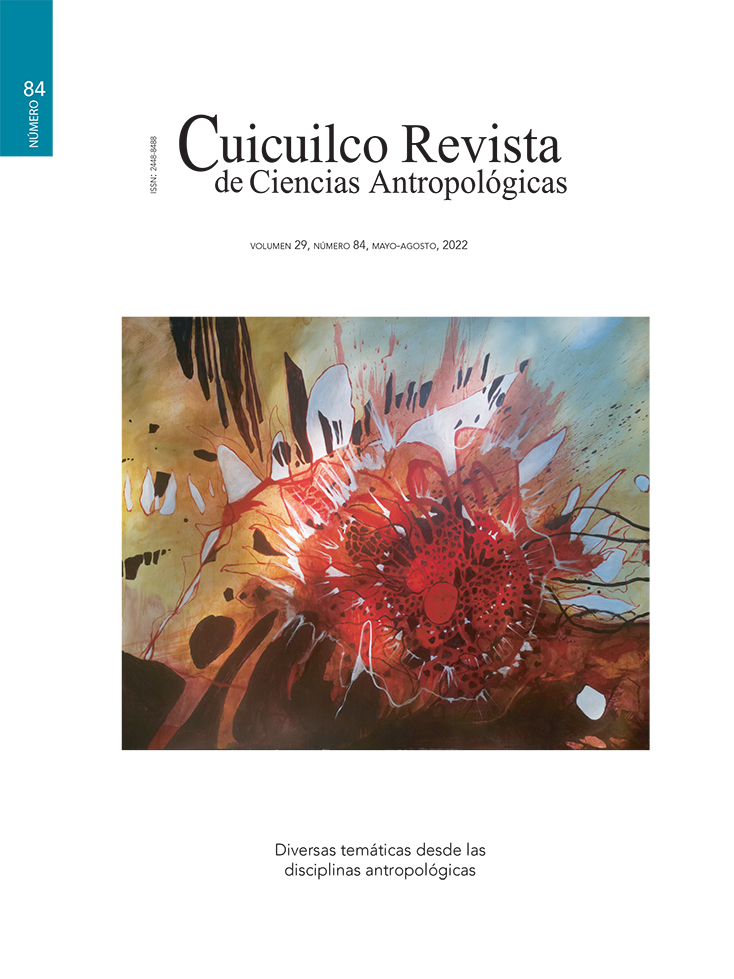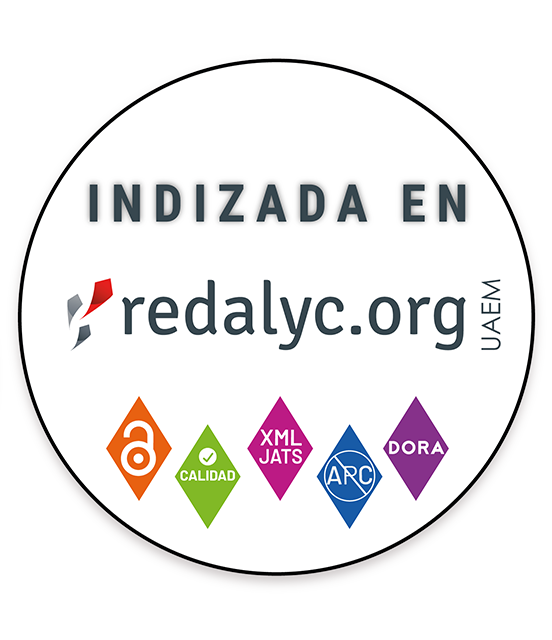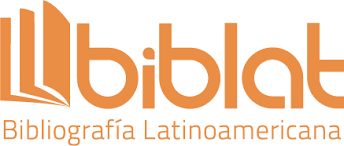“Cold” and “hot” in Mexico: categories, domains and distribution of a Mesoamerican folk classification system
Keywords:
hot-cold system, humoral classification, application domains, hot-cold system distribution, MesoamericaAbstract
“Cold” and “hot” are the basic categories used in the Mesoamerican system of object and concept classification. Although widely documented in the literature, the information is scattered and deserves to be explored and integrated. The aim was to reanalyze and describe three aspects of the hot-cold system: the terms and categories of classification, the domains of applicability, and their geographic and cultural extension. Information was synthesized from various bibliographic sources on different human groups and places in Mexico. There are categories and terms in the classification that differ between cultures and places. The system is applied in several domains such as the human body, the environment and emotions. Apparently the hot-cold system is mainly used
by the ethnolinguistic groups of the Mesoamerican area and less in northern Mexico. This paper shows how complex, flexible, diverse and extensive this folk taxonomic system is in Mexico.
Downloads
References
Álvarez Heydenreich, Laurencia
La enfermedad y la cosmovisión en Hueyapan, Morelos. INI. México.
Bartolomé, Miguel Alberto
Reflexiones sobre las identidades de los grupos étnicos. Arqueología Mexicana, 28 (171), noviembre-diciembre: 36-41.
Cosminsky, Sheila
Changing food and medical beliefs and practices in a Guatemalan community. Ecology of Food and Nutrition, 4 (3): 183-191.
Currier, Richard L.
The hot-cold syndrome and symbolic balance in Mexican and Spanish-American folk medicine. Ethnology, 5 (3), julio: 251-263.
Felger, Richard Stephen y Mary Beck Moser
People of the Desert and Sea. Ethnobotany of the Seri Indians. The University Arizona Press. Tucson, Arizona.
Foster, George M.
Empire’s Children. The People of Tzintzuntzan. Smithsonian Institution (Publications of the Institute of Social Anthropology) (6). Washington, D.C.
Relationships between Spanish and Spanish-American folk medicine. The Journal of American Folklore, 66 (261), julio-septiembre: 201-217.
Tzintzuntzan. Los campesinos en un mundo en cambio, Porfirio Martínez Peñaloza (trad.). Fondo de Cultura Económica. México.
El legado hipocrático latinomericano: “caliente” y “frío” en la medicina popular contemporánea. Medicina Tradicional, 2 (6): 5-21.
Hippocrates’ Latin American Legacy. Humoral Medicine in the New World, vol. 1. Gordon and Breach (Theory and Practice in Medical Anthropology and International Health). Langhorne, PA.
De la Fuente Chicoséin, Julio
Yalálag. Una villa zapoteca serrana, vol. 2. CDI. México.
García-Hernández, Karina Yaredi
El sistema mesoamericano frío-caliente en la medicina tradicional y la alimentación: una perspectiva etnobotánica, tesis de doctorado. Posgrado en Botánica-Colegio de Postgraduados. Texcoco, Estado de México. México.
García-Hernández, Karina Yaredi, Heike Vibrans, Patricia Colunga-García Marín et al.
Climate and categories: Two key elements for understanding the Mesoamerican hot-cold classification of illnesses and medicinal plants. Journal of Ethnopharmacology, 266: 113-419.
Geck, Matthias S., Stefano Cabras, Laura Casu et al.
The taste of heat: How humoral qualities act as a cultural filter for chemosensory properties guiding herbal medicine. Journal of Ethnopharmacology, 198: 499-515.
Holland, William R.
Medicina maya en los Altos de Chiapas. Un estudio del cambio socio-cultural. INI. México.
Ingham, John M.
On Mexican folk medicine. American Anthropologist, 72 (1), febrero: 76-87. Instituto de Cultura de Yucatán
Fiestas patronales y gastronomía de la cultura maya-yucateca. Instituto de Cultura de Yucatán. México.
Instituto Nacional de Lenguas Indígenas (INALI)
Catálogo de las lenguas indígenas nacionales. Variantes lingüísticas de México con sus autodenominaciones y referencias geoestadísticas. INALI. México.
Instituto Nacional de los Pueblos Indígenas (INPI)-Instituto Nacional de Lenguas Indígenas (INALI)
Cochimíes-Etnografía. Atlas de los pueblos indígenas de México <http://atlas.inpi.gob.mx/cochimies-etnografia/>. Consultado el 6 de diciembre de 2021.
Katz, Esther
Del frío al exceso de calor: dieta alimenticia y salud en la Mixteca, en Medicina tradicional, herbolaria y salud comunitaria en Oaxaca, Paola Sesia (ed.). Centro de Investigaciones y Estudios Superiores en Antropología Social, Gobierno del Estado de Oaxaca. Oaxaca, México: 99-113.
Recovering after childbirth in the Mixtec highlands (Mexico), en Medicaments et Aliments: L’Approche Ethnopharmacologique, Ekkehard Schroeder, Guy Balansard, Pierre Cabalion, et al. (eds.). orstom-Société Française d’Ethno-pharmacologie. Paris-Metz, Francia: 97–109. <http://horizon.documentation.ird.fr/exl-doc/pleins_textes/pleins_textes_6/colloques2/010005524.pdf>. Consultado el 8 de octubre de 2017.
Vapor, aires y serpientes. Meteorología en la “Tierra de la Lluvia” (Mixteca Alta, Oaxaca), en Aires y lluvias. Antropología del clima en México, Annamária Lammel, Marina Goloubinoff y Esther Katz (eds.). CIESAS, CEMCA, Institut de Recherche pour le Développement (Publicaciones de la Casa Chata). México: 283-322.
Logan, Michael H.
Humoral medicine in Guatemala and peasant acceptance of modern medicine. Human Organization, 32 (4): 385-395.
López Austin, Alfredo
Cuerpo humano e ideología. Las concepciones de los antiguos nahuas, vol. 1. IIA-UNAM. México.
Lorente Fernández, David
El «frío» y el «calor» en el sistema médico nahua de la sierra de Texcoco: Una aproximación. Revista Española de Antropología Americana, 42 (1): 251–260.
Madsen, William
Hot and cold in the universe of San Francisco Tecospa, Valley of Mexico. The Journal of American Folklore, 68 (268), april-june: 123-139.
Mathews, Holly F.
Context-specific variation in humoral classification. American Anthropologist, 85 (4), march: 826-847.
McCullough, John M.
Human ecology, heat adaptation, and belief systems: The hot-cold syndrome of Yucatan. Journal of Anthropological Research, 29 (1): 32-36.
Messer, Ellen
Hot-cold classification: Theoretical and practical implications of a Mexican study. Social Science & Medicine, 15b (2): 133-145.
Neuenswander, Helen L. y Shirley D. Souder
El síndrome caliente-frío, húmedo-seco entre los quichés de Joyabaj: Dos modelos cognitivos. Guatemala Indígena, 15 (1-2), enero-junio: 149-169.
Olavarrieta Marenco, Marcela
Magia en los Tuxtlas, Veracruz. Conaculta, INI. México.
Petrich, Perla
La alimentación mochó: acto y palabra (estudio etnolingüístico). Universidad Autónoma de Chiapas. San Cristóbal de las Casas, Chiapas. México.
Redfield, Robert y Alfonso Villa Rojas
Chan Kom. A Maya Village. The University of Chicago Press. Chicago.
Ryesky, Diana
Conceptos tradicionales de la medicina en un pueblo mexicano: Un análisis antropológico, Yolanda Sassoon (trad.). SEP. México.
Signorini, Italo
Los huaves de San Mateo del Mar. INI (Antropología Social, 59). México.
Young, James Clay
Medical Choice in a Mexican Village. Rutgers University Press. New Brunswick, Nueva Jersey.
Downloads
Published
Versions
- 2023-04-23 (2)
- 2022-09-29 (1)







